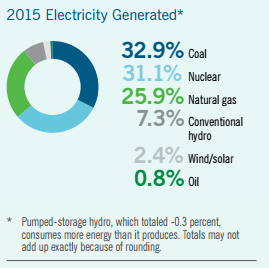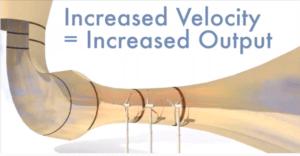An Energy Provider’s Push to Modernize the Power Grid and Generate Cleaner Energy

Energy providers are in a position to have a major impact on the way we utilize electricity. One energy provider is taking all the right steps to ensure there is a brighter tomorrow.
The Intergovernmental Panel on Climate Change has shown that there will be severe implications ecologically and financially if the world does not make immediate changes to stabilize global temperature to less than 2°C of pre-industrial levels by the end of the 21st century.[1] Although the seriousness of the effects of climate change are becoming increasingly undeniable, there is a lack of globally agreed upon solutions. With 25% of greenhouse gas emissions coming from fossil fuels used to generate electricity and heat [1], energy distributors can expect to see increases in federal regulations, such as the Clean Power Plan, to reduce carbon pollution from power plants.[2]
Addressing Climate Change Concerns
Duke Energy (DE), an energy company providing electricity to customers in the Southeast and Midwest regions of the United States, is working to reduce their carbon footprint by expanding their natural gas and renewable energy segments, investing in “smart grid” technology and carbon capture research, and decommissioning old, inefficient coal plants.[3]
Their expansion into cleaner and renewable energy is demonstrated by their 2016 acquisition of Piedmont Natural Gas, which will triple their natural gas customers to 1.5 million, and their involvement with the Atlantic Coast and Sabal Trail Natural Gas Pipelines.[4] DE is expecting to have invested roughly $7 billion in wind and solar projects by 2020.[4] Their 2014 and 2015 environmental performance metrics show that DE has decreased their electricity generated from fossil fuels by 6% and increased carbon-free production by 6%. Additionally, production of electricity by solar and wind has increased by 14% (figure 1).[5] [6]
Figure 1: Duke Energy 2014 vs 2015 Electricity Generation Comparison [5] [6]
DE is utilizing digital technology to improve the efficiency of electricity delivery from substations to customer homes. This improves the company’s ability to connect with renewable energy resources such as solar and wind power. It also provides customers with information on household energy usage, allowing them to better control their energy consumption. This will decrease the customer’s bill while also decreasing DE’s capacity needs.[7] The International Renewable Energy Agency has indicated that the benefits of smart grid technologies outweigh the costs. They reference a 2012 US study by Rudden and Rudden that showed that the benefits of investments in sustainable technologies have a net present value of $20-25 Billion. They also express how issues with fluctuating sources of energy (i.e., wind and solar) can be mitigated with technologies like smart grids that provide control over how and where electricity is sourced.[8]
DE is also conducting an ongoing decommissioning of older coal plants and replacing them with more efficient, advanced plants. They are supporting research with algae, and whether it can be utilized to reduce CO2 emissions by coal power plants. DE has submitted applications to the Nuclear Regulatory Commission (NRC) to construct new nuclear power plants which would provide local jobs and tax revenues.[3] These initiatives appear to be in response to climate change and in preparation for future CO2 emission reduction requirements. While there is still much work to be done, the reduction in US CO2 emissions by 25% between 2005 and 2015 [4] is a step in the right direction.
Taking Action for the Future
DE should focus on partnering with companies attempting to create innovative technologies in renewable resources. DE is limited by its inability to install traditional wind technologies close to more populated regions to reduce the difficulty of transferring excess power over long distances. They should increase partnerships with companies such as Sheerwind who developed an omni-directional air intake system that is cheaper, more efficient, and more adaptive to different geographies (figure 2).[9] [10] Other fruitful partnerships could come from GE and Tesla who have both made strides in battery storage and solar power on a city and personal home scale, respectively.[11] [12] Through these partnerships DE can be a role model for other energy suppliers and have a leading voice in the fight against climate change.
Figure 2: Sheerwind Wind Funnel Power Generator [10]
(Word Count: 787)
[1] “Climate Change 2014: Synthesis Report,” Intergovernmental Panel on Climate Change, 2014, https://www.ipcc.ch/pdf/assessment-report/ar5/syr/SYR_AR5_FINAL_full_wcover.pdf, accessed November 2016.
[2] US Environmental Protection Agency. “Clean Power Plan for Existing Power Plants.” https://www.epa.gov/cleanpowerplan/clean-power-plan-existing-power-plants, accessed November 2016.
[3] Duke Energy, “Sustainability.” https://www.duke-energy.com/our-company/sustainability, accessed November 2016.
[4] Duke Energy, 2015 Annual Report. file:///C:/Users/Anthony/Downloads/Annual%20Report%202015.pdf, accessed November 2016.
[5] Duke Energy, 2014 Sustainability Report. http://sustainabilityreport.duke-energy.com/2014/pdfs/2014-duke-sustainability-report-environmental-metrics.pdf, accessed November 2016.
[6] Duke Energy, 2015 Sustainability Report. http://sustainabilityreport.duke-energy.com/pdfs/15-duke-sr-environmental-metrics.pdf, accessed November 2016.
[7] Duke Energy, “Smart Grid.” https://www.duke-energy.com/our-company/about-us/smart-grid, accessed November 2016.
[8] Kempener, Ruud. “Smart Grids and Renewables.” International Renewable Energy Agency (IRENA) Working Paper, 2013. http://www.irena.org/documentdownloads/publications/smart_grids.pdf, accessed November 2016.
[9] Allaei, Daryoush, et al. “INVELOX with Multiple Wind Turbine Generator Systems.” Energy 93, (2015): 1030-1040. via Science Direct, accessed November 2016.
[10] Sheerwind. “Technology.” http://sheerwind.com/technology, accessed November 2016.
[11] GE Renewable Energy. “Innovative Renewable Energy Solutions.” https://www.gerenewableenergy.com/innovative-solutions.html, accessed November 2016.
[12] Tesla. “Sustainably Power your Home or Business.” https://www.tesla.com/energy, accessed November 2016.







How do companies like DE cope with the double-edged sword of shifting to renewables? On the one hand, it diversifies their energy portfolio, making it easier to cope with mounting regulatory requirements and produce at lower cost over the long-term. On the other hand, however, it can reduce their total revenues as consumers – and not just the energy providers – follow a similar path by shifting to their own sources of independent renewable energy, which allow them to effectively disconnect from the grid. Is DE making any other investments (e.g., transmission systems, etc.) to offset the potential reduction in load as consumers follow a similar path?
Really informative blog post. This is not an area I am particularly au fait with and the details here have contributed a great deal in my wrapping my head around the sheer scale of environmental impact of switching the renewable energy. One thing I have heard quite a bit about is the need for energy storage to capture the constant fluctuations in energy generation with solar and wind solutions. Is DE exploring storage?
Thank you Anthony, really interesting company!
It is great to know that there are new options to change the energy source into more sustainable and cheap ones, since most of the time these to characteristics are not aligned and the consumer is affected by price increments.
I have the impression that this company is not aligned with consumer needs: I feel they try to reduce consumer’s consumption of energy, but also I imagine they want to generate more profits and sustain the business. How do you think this company can fix the misalignment in goals? Is this possible?
Great article outlining what Duke is doing to reduce its carbon footprint. You mention in the last paragraph that Duke has been pursuing the acquisition and ownership of wind and solar project and decommissioning of coal plants “in response to climate change and in preparation for future CO2 emission reduction requirements”. I wonder how much of this activity is driven by preparation of potential future CO2 emission reduction requirements, versus being driven by current economics. It seems to me that it would be unlikely that Duke would shut down a coal plant, a major capital investment, if it still made economic sense in today’s markets. I wonder if the plants that they are shutting down are simply because they have run their full life cycle and are no longer economic to run because of the high amount of capital expenditures required to keep the plant running and/or if they are no longer profitable given that they are competing with historically extremely cheap natural gas and power prices. I also wonder how much of their investment in renewable projects are driven by state mandated RPS requirements and lucrative tax benefits.